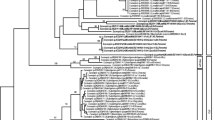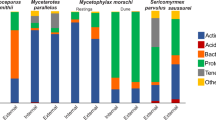Abstract
Leafcutter ants (Formicidae: tribe Attini) are well-known insects that cultivate basidiomycete fungi (Agaricales: Lepiotaceae) as their principal food. Fungus gardens are monocultures of a single cultivar strain, but they also harbor a diverse assemblage of additional microbes with largely unknown roles in the symbiosis. Cultivar-attacking microfungi in the genus Escovopsis are specialized parasites found only in association with attine gardens. Evolutionary theory predicts that the low genetic diversity in monocultures should render ant gardens susceptible to a wide range of diseases, and additional parasites with roles similar to that of Escovopsis are expected to exist. We profiled the diversity of cultivable microfungi found in 37 nests from ten Acromyrmex species from Southern Brazil and compared this diversity to published surveys. Our study revealed a total of 85 microfungal strains. Fusarium oxysporum and Escovopsis were the predominant species in the surveyed gardens, infecting 40.5% and 27% of the nests, respectively. No specific relationship existed regarding microfungal species and ant-host species, ant substrate preference (dicot versus grass) or nesting habit. Molecular data indicated high genetic diversity among Escovopsis isolates. In contrast to the garden parasite, F. oxysporum strains are not specific parasites of the cultivated fungus because strains isolated from attine gardens have similar counterparts found in the environment. Overall, the survey indicates that saprophytic microfungi are prevalent in South American leafcutter ants. We discuss the antagonistic potential of these microorganisms as “weeds” in the ant–fungus symbiosis.


Similar content being viewed by others
References
Altschul SF, Madden TL, Schaffer AA, Zhang J, Zhang Z, Miller W, Lipman D (1997) Gapped BLAST and PSI-BLAST: a new generation of protein database search programs. Nucleic Acids Res 1:3389–3402
Bacci M Jr, Ribeiro SB, Casarotto MEF, Pagnocca FC (1995) Biopolymer-degrading bacteria from nests of the leaf-cutting ant Atta sexdens rubropilosa. Braz J Med Biol Res 28:79–82
Bandelt H-J, Foster P, Röhl A (1999) Median-joining networks for inferring intraspecific phylogenies. Mol Biol Evol 16:37–48
Barron GL (1968) The genera of hyphomycetes from soil. Robert E. Krieger, New York
Batra LR (1979) Insect–fungus symbiosis: nutrition, mutualism and commensalisms. Allanheld, Osmun, Montclair
Bourtzis K, Miller TA (2006) Insect symbiosis, vol 2. CRC Press, Florida
Brown JM, Lemmon AR (2007) The importance of data partitioning and the utility of Bayes factors in Bayesian phylogenetics. Syst Biol 56:643–655
Cafaro MJ, Currie CR (2005) Phylogenetic analysis of mutualistic filamentous bacteria associated with fungus-growing ants. Can J Microbiol 51:441–446
Carreiro SC, Pagnocca FC, Bueno OC, Bacci M Jr, Hebling MJA, Silva OA (1997) Yeasts associated with nests of the leaf-cutting ant Atta sexdens rubropilosa Forel, 1908. Antonie van Leeuwenhoek 71:243–248
Craven SE, Dix MW, Michaels GE (1970) Attine fungus gardens contain yeasts. Science 169:184–186
Currie CR, Mueller UG, Malloch D (1999) The agricultural pathology of ant fungus gardens. Proc Natl Acad Sci U S A 96:7998–8002
Currie CR (2001) Prevalence and impact of a virulent parasite on a tripartite mutualism. Oecologia 128:99–106
Currie CR, Stuart AE (2001) Weeding and grooming of pathogens in agriculture by ants. Proc R Soc Lond B 268:1033–1039
Currie CR, Wong B, Stuart AE, Schultz TR, Rehner SA, Mueller UG, Sung GH, Spatafora JW, Straus NA (2003) Ancient tripartite coevolution in the attine ant–microbe symbiosis. Science 299:386–388
Domsch KH, Gams W, Anderson T (1980) Compendium of soil fungi, vol. 1 and 2. Academic, London
Druzhinina IS, Kopchinskiy AG, Komon M, Bissett J, Szakacs G, Kubicek CP (2005) An oligonucleotide barcode for species identification in Trichoderma and Hypocrea. Fungal Genet Biol 42:813–828
Felsenstein J (1985) Confidence limits on phylogenies: an approach using de bootstrap. Evolution 39:783–791
Fernández-Marín H, Zimmerman JK, Rehner SA, Wcislo WT (2006) Active use of the metapleural glands by ants in controlling fungal infection. Proc R Soc Lond B 273:1689–1695
Fisher PJ, Stradling DJ, Sutton BC, Petrini LE (1996) Microfungi in the fungus gardens of the leaf-cutting ant Atta cephalotes: a preliminary study. Mycol Res 100:541–546
Gerardo NM, Currie CR, Price SL, Mueller UG (2004) Exploiting a mutualism: parasite specialization on cultivars within the fungus-growing ants symbiosis. Proc R Soc Lond B 271:1791–1798
Gerardo NM, Mueller UG, Currie CR (2006) Complex host–pathogen coevolution in the Apterostigma fungus-growing ant–microbe symbiosis. Evol Biol 6:88–97
Gonçalves CR (1961) O Gênero Acromyrmex no Brasil (Hym. Formicidae). Stud Entomol 4:113–180
Hall TA (1999) BioEdit: a user-friendly biological sequence alignment editor and analysis program for Windows 95/98/NT. Nucl Acids Symp Ser 41:95–98
Hamilton WD, Axelrod R, Tanese R (1990) Sexual reproduction as an adaptation to resist parasites (a review). Proc Natl Acad Sci U S A 87:3566–3573
Hölldobler B, Wilson EO (1990) The ants. Harvard University Press, Cambridge
Klich MA (2002) Identification of common Aspergillus species. Centraalbureau voor Schimmelcultures, Baarn
Lee JS, Ko KS, Jung HS (2000) Phylogenetic analysis of Xylaria based on nuclear ribosomal ITS1–5.8S-ITS2 sequences. FEMS Micro Lett 187:89–93
Liu XY, Huang H, Zheng RY (2001) Relationships within Cunninghamella based on sequence analysis of ITR rDNA. Mycotaxon 80:77–95
Möller A (1893) Die Pilzgärten einiger südamerikanischer Ameisen. Bot Mittl Trop 6:1–127
Mueller UG, Schultz TR, Currie CR, Adams RMM, Malloch D (2001) The origin of the attine ant–fungus mutualism. Q Rev Biol 76:169–197
Mueller UG (2002) Ant versus fungus versus mutualism: Ant-cultivar conflict and the deconstruction of the attine ant–fungus symbiosis. Am Nat 160(Suppl.):S67–98
Mueller UG, Gerardo NM, Aanen DK, Six DL, Schultz TR (2005) The evolution of agriculture in insects. Annu Rev Ecol Evol Syst 36:563–595
Nelson PE, Toussoun TA, Marasas WFO (1983) Fusarium species: an illustrated manual for identification. The Pennsylvania State University Press, Pennsylvania
O’Donnell K, Cigelnik E (1998) Two divergent intragenomic rDNA ITS2 types within a monophyletic lineage of the fungus Fusarium are nonorthologous. Mol Phylogenet Evol 7:103–116
Poulsen M, Currie CR (2006) Complexity of insect–fungal associations: exploring the influence of microorganisms on attine ant–fungus symbiosis. In: Bourtzis K, Miller TA (eds) Insect symbiosis, vol. 2. CRC, Boca Raton, FL, USA, pp 57–77
Poulsen M, Boomsma J (2005) Mutualistic fungi control crop diversity in fungus-growing ants. Science 307:741–744
Reynolds HT, Currie CR (2004) Pathogenicity of Escovopsis weberi: The parasite of the attine–microbe symbiosis directly consumes the ant-cultivated fungus. Mycologia 96:955–959
Rodrigues A, Pagnocca FC, Bacci M Jr, Hebling MJA, Bueno OC, Pfenning LH (2005) Variability of non-mutualistic filamentous fungi associated with Atta sexdens rubropilosa nests. Folia Microbiol 50:421–425
Rodrigues A, Pagnocca FC, Bueno OC, Pfenning LH, Bacci M Jr (2005) Assessment of microfungi in fungus gardens free of the leaf-cutting ant Atta sexdens rubropilosa (Hymenoptera: Formicidae). Sociobiology 46:329–334
Ronquist F, Huelsenbeck JP (2003) MrBayes 3: bayesian phylogenetic inference under mixed models. Bioinformatics 19:1572–1574
Sambrook J, Russel DW (2001) Molecular cloning: a laboratory manual, 3rd ed. Cold Spring Harbor Laboratory Press, New York
Samson RA, Hoekstra ES, Frisvad JC (2000) Introduction to food-airborne fungi, 6th ed. Centraalbureau voor Schimmelcultures, Baarn
Schultz TR, Meier R (1995) A phylogenetic analysis of the fungus-growing ants (Formicidae: Attini) based on morphological characters of the larvae. Syst Entomol 20:337–370
Silva A, Bacci M Jr, Siqueira CG, Bueno OC, Pagnocca FC, Hebling MJA (2003) Survival of Atta sexdens workers on different food sources. J Insect Physiol 49:307–313
Silva A, Rodrigues A, Bacci M Jr, Pagnocca FC, Bueno OC (2006) Susceptibility of ant-cultivated fungus Leucoagaricus gongylophorus (Agaricales: Basidiomycota) towards microfungi. Mycopathologia 162:115–119
Skovgaard K, Nirenberg HI, O’Donnell K, Rosendahl S (2001) Evolution of Fusarium oxysporum f. sp. vasinfectum races inferred from multigene genealogies. Phytopathology 91:1231–1237
Swofford DL (2002) PAUP*: Phylogenetic analysis using parsimony (*: and other methods), ver. 4. Sinauer Associates, Massachusetts
Taerum SJ, Cafaro MJ, Little AEF, Schultz TR, Currie CR (2007) Low host–pathogen specificity in the leaf-cutting ant–microbe symbiosis. Proc R Soc Lond B 274:1971–1978
Thompson JD, Higgins DG, Gibson TJ (1994) CLUSTAL W: improving the sensitivity of progressive multiple sequence alignment through sequence weighting, position specific gap penalties and weight matrix choice. Nucleic Acids Res 22:4673–4680
Weber NA (1972) Gardening ants: the attines, vol. 92 Memoirs of the American Philosophical Society, Philadelphia
White TJ, Bruns T, Lee S, Taylor J (1990) Amplification and direct sequencing of fungal ribosomal RNA genes for phylogenetics. In: Innis MA, Gelfand DH, Sninsky JJ, White TJ (eds) PCR protocols: A guide to methods and applications. Academic, California, pp 315–321
Zwickl DJ (2006) Genetic algorithm approaches for the phylogenetic analysis of large biological sequence datasets under the maximum likelihood criterion. Ph.D. dissertation, The University of Texas at Austin
Acknowledgements
We would like to thank the “Conselho Nacional de Desenvolvimento Científico e Tecnológico (CNPq)” for a scholarship supporting A Rodrigues, “Fundação de Amparo a Pesquisa Científica do Estado de São Paulo” (FAPESP) for funding the fieldwork; and DC Marini and J Martins Jr for laboratory support. We are also grateful to A Silva for comments on earlier versions of this manuscript as well as NM Gerardo and one anonymous referee for kindly reviewing this manuscript. We also thank SE Solomon for helping with the phylogenetic analyses.
Author information
Authors and Affiliations
Corresponding author
Rights and permissions
About this article
Cite this article
Rodrigues, A., Bacci Jr, M., Mueller, U.G. et al. Microfungal “Weeds” in the Leafcutter Ant Symbiosis. Microb Ecol 56, 604–614 (2008). https://doi.org/10.1007/s00248-008-9380-0
Received:
Revised:
Accepted:
Published:
Issue Date:
DOI: https://doi.org/10.1007/s00248-008-9380-0




